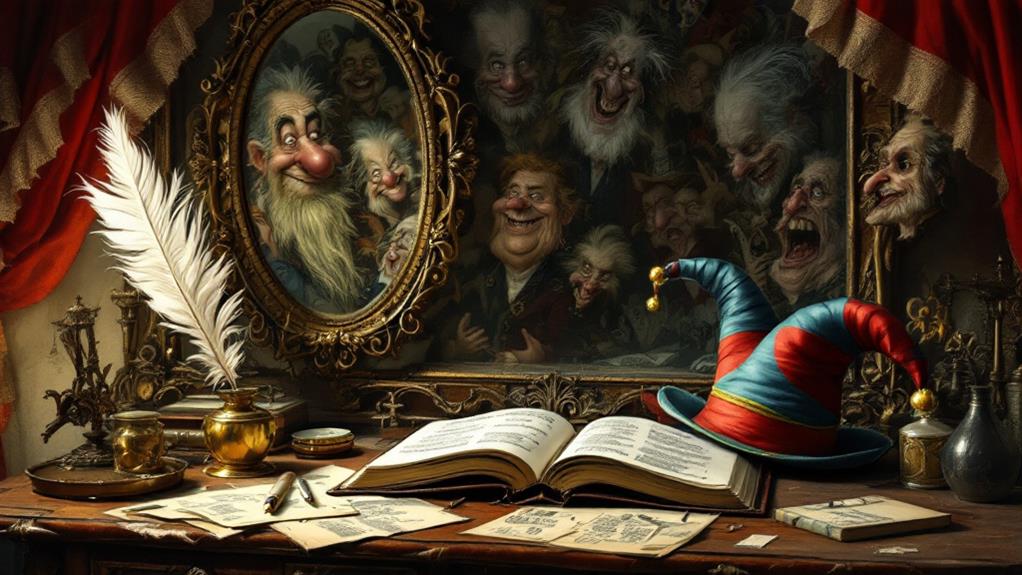What Is Wit and Satire?

Wit and satire are clever language tools that challenge your thinking and society's norms. Wit involves quick, intelligent humor through wordplay and unexpected connections. Satire uses wit, irony, and exaggeration to criticize human folly and societal flaws. Both have ancient roots, with examples from Greek philosophers to modern comedians. You'll find wit in clever comebacks and wordplay, while satire appears in literature, political cartoons, and social commentary. These devices can shape public opinion, cultivate community, and even provoke change. As you examine further, you'll uncover how wit and satire have influenced culture throughout history.
Defining Wit and Satire
Wit and satire are two closely related literary devices that pack a powerful punch in both written and spoken communication. You'll find that wit is characterized by its clever and intelligent use of language, often amusing but not always humorous. It's a display of mental agility, showcasing the speaker's perception and intelligence.
Satire, on the other hand, employs wit, humor, and irony to critique and expose human follies and societal flaws. It's a powerful tool for social commentary, aiming to challenge perceptions and provoke thought. While wit can stand alone, satire often incorporates wit to achieve its goals.
Both wit and satire rely on the juxtaposition of familiar concepts with unexpected twists, forcing you to reconsider your assumptions. They can be applied to a wide range of situations, from light-hearted banter to serious social criticism. You'll notice that wit primarily demonstrates the speaker's cleverness, while satire targets broader systems and behaviors.
Understanding these devices helps you appreciate their use in literature, comedy, and everyday conversation. They're not just entertaining; they're effective tools for communication and critique.
Historical Origins
The roots of wit and satire stretch back to ancient Greece, where philosophers like Aristotle pondered their nature and purpose. Aristotle associated wit with "educated insolence" and recognized satire as a tool for delivering moral lessons. This early understanding laid the foundation for centuries of literary and philosophical exploration.
As you trace the evolution of wit and satire, you'll find that many great thinkers and writers have contributed to their development. The French philosopher Denis Diderot coined the term "staircase wit," an example of wit that describes the frustrating experience of thinking of the perfect comeback too late. Examples of wit and satire abound in English literature, with experts like Shakespeare, Dryden, and Sheridan often using these devices to entertain and provoke thought.
German philosopher Friedrich Nietzsche viewed wit as the "epitaph of an emotion," while Jonathan Swift, the Irish satirist, described satire as a mirror reflecting human flaws. In America, critics like Dorothy Parker further refined our understanding by distinguishing between mere "wise-cracking" and true wit, highlighting the multi-layered nature of verbal humor.
Key Characteristics

From these historical foundations, we can identify several key characteristics that define wit and satire. Both forms of expression use humor as a vehicle for conveying deeper messages or critiques. Wit relies on clever wordplay, puns, and unexpected connections to provoke laughter and admiration for the speaker's intellect. You'll often find wit in quick-fire exchanges or well-crafted one-liners that demonstrate mental agility.
Satire, on the other hand, employs humor to expose and criticize societal flaws, human vices, or political shortcomings. It's typically more sustained and can take various forms, from written works to visual media. You'll recognize satire by its use of irony, exaggeration, or ridicule to make its point. Both wit and satire require a keen understanding of language, culture, and human nature.
Another key characteristic is the element of surprise. Whether it's a witty retort or a satirical twist, the unexpected nature of these forms keeps audiences engaged and thinking. They challenge you to look beyond the surface and consider alternative viewpoints, often using laughter as a tool for reflection and critique.
Types of Wit
Diversity characterizes the world of wit, with several distinct types that you'll encounter in literature, comedy, and everyday conversation. Verbal wit, perhaps the most common form, relies on clever wordplay and linguistic manipulation. You'll find it in puns, double entendres, and witty comebacks that exploit language's ambiguities.
Observational wit stems from humorous observations about everyday life, society, or human behavior. It's the bread and butter of many stand-up comedians, who point out absurdities we often overlook. Situational wit involves quick thinking and the ability to respond cleverly to unexpected circumstances, often resulting in impromptu jokes or quips.
Intellectual banter, a more sophisticated form of wit, showcases one's knowledge and mental agility. It's characterized by rapid exchanges of ideas, often peppered with cultural references and subtle jabs. Sarcastic wit, on the other hand, employs irony to mock or criticize, sometimes with a biting edge. Ultimately, there's self-deprecating wit, where individuals poke fun at themselves, displaying both humor and humility. Each type of wit serves different purposes and appeals to varied audiences, nourishing our communication and entertainment.
Forms of Satire

Three primary forms of satire exist: Horatian, Juvenalian, and Menippean. You'll find that each type employs different techniques to critique society, politics, or human nature. Horatian satire uses gentle, often self-deprecating humor to poke fun at human folly. It's light-hearted and aims to correct through laughter. Juvenalian satire, on the other hand, is harsh and biting, using irony in satire to attack vice and corruption.
Menippean satire targets mental attitudes rather than specific individuals or institutions. It often uses a comedic tone in satire to criticize abstract ideas or philosophies. When exploring these forms, you'll encounter various satirical techniques, including:
- Parody as satire
- Exaggeration
- Incongruity
- Reversal
- Analogy
These methods help satirists convey their message effectively. For instance, parody mimics the style of its target, often exaggerating characteristics for comedic effect. Irony in satire creates a contrast between what's said and what's meant, highlighting absurdities. By understanding these forms and techniques, you'll better appreciate the complexity and artistry behind effective satire, whether you're reading a classic novel or watching a modern comedy show.
Famous Satirists and Wits
Throughout history, certain writers and thinkers have risen to prominence for their razor-sharp wit and biting satire. You'll find that these experts of social commentary have left an unforgettable mark on literature and society.
Jonathan Swift, best known for "Gulliver's Travels," exposed the follies of 18th century English society through his scathing satire. Oscar Wilde's witty, aphoristic style challenged Victorian norms, while Dorothy Parker's sardonic commentary skewered the 1920s New York elite. These writers excelled at cultural mockery, using their sharp tongues to point out societal hypocrisies.
For political critique, you need look no further than Voltaire. This French Enlightenment writer wielded satire as a weapon against religious dogma and political oppression. Similarly, Mark Twain's satirical humor targeted racism, greed, and the pretensions of 19th century America.
You'll notice that these satirists and wits share a common thread: they used their literary talents to challenge the status quo. Their works continue to echo today, reminding us of the power of wit and satire to provoke thought, inspire change, and expose societal flaws through laughter and mockery.
Literary Examples

In addition to the famous satirists mentioned earlier, you'll find a wealth of literary examples that showcase wit and satire across genres and eras. When analyzing literature, you'll encounter numerous works that employ these literary devices to critique society, politics, and human nature.
Some notable examples of wit and satire in literature include:
- Jonathan Swift's "A Modest Proposal"
- George Orwell's "Animal Farm"
- Jane Austen's "Pride and Prejudice"
- Mark Twain's "The Adventures of Huckleberry Finn"
- Oscar Wilde's "The Importance of Being Earnest"
These works demonstrate various literary techniques used to convey satirical messages. Swift's biting irony, Orwell's allegorical approach, Austen's subtle social commentary, Twain's use of vernacular language, and Wilde's clever wordplay all serve to engage readers while imparting pointed critiques.
When conducting literary analysis, you'll notice how authors employ wit and satire to expose societal flaws, challenge authority, or highlight human follies. By studying these examples, you'll gain a deeper understanding of how these literary devices function and their lasting impact on literature and society.
Visual Arts and Satire
Cartoonists and visual artists have long wielded satire as a powerful tool to critique society and politics. You'll find that caricature as social commentary is a prevalent technique, exaggerating physical features to highlight character flaws or societal issues. Artists use distorted representations of public figures to expose their perceived shortcomings or challenge their authority.
Symbolism in satirical art plays an essential role in conveying complex ideas through visual metaphors. You might encounter animals representing countries, objects symbolizing abstract concepts, or allegorical figures embodying societal ills. These symbols allow artists to communicate layered messages that resonate with viewers on multiple levels.
Political cartoons as wit offer a unique blend of humor and criticism. They condense complex political situations into single-panel illustrations, often employing wordplay and visual puns to drive home their point. You'll notice how these cartoons can spark debate, influence public opinion, and even shape political discourse.
As you investigate satirical visual arts, you'll uncover how artists use these techniques to challenge the status quo, provoke thought, and inspire change through their biting wit and clever commentary.
Wit in Popular Culture

Wit permeates popular culture, manifesting in various forms of entertainment and media. You'll find clever wordplay and ironic commentary across various platforms, from movies and TV shows to advertising and music. Witty protagonists like those in Firefly captivate audiences with their sarcastic repartee, while spy franchises like James Bond showcase the art of the quip in high-stakes situations.
In the world of advertising, wit serves as a powerful tool to create memorable taglines that stick in consumers' minds. Meanwhile, battle rap performances elevate wit to an art form, with artists crafting intricate, rhythmic comebacks on the spot.
Clever one-liners in action movies, sarcastic TV characters, wordplay in advertising slogans, satirical political cartoons, and witty exchanges in rap battles are some common examples of wit in popular culture.
As you traverse the media milieu, you'll encounter wit in various forms, from subtle jabs to blatant mockery. This ingenious use of language not only enthralls but also provides commentary on society, politics, and human nature, making it a pivotal element in shaping our cultural discourse.
Impact on Society
Beyond entertainment, wit and satire wield significant influence on society. You'll find their impact reaching far beyond mere laughter, as they serve as powerful tools for social commentary and political critique. When you encounter clever quips or biting satire, you're often engaging with complex ideas presented in digestible, memorable forms.
These forms of humor can challenge your preconceptions, encouraging you to think critically about societal norms and political structures. They've played pivotal roles in shaping public opinion throughout history, from ancient Greek plays to modern late-night shows. You might find yourself questioning authority or reconsidering long-held beliefs after exposure to well-crafted satire.
Wit and satire's cultural influence extends to language itself, augmenting vocabulary and spawning catchphrases that become part of everyday discourse. They can unite people through shared understanding of jokes and references, fostering a sense of community. However, they can also be divisive, particularly when tackling sensitive topics. As you navigate the world of wit and satire, you'll uncover their power to entertain, educate, and provoke change in society.




